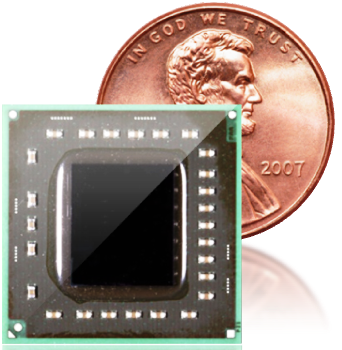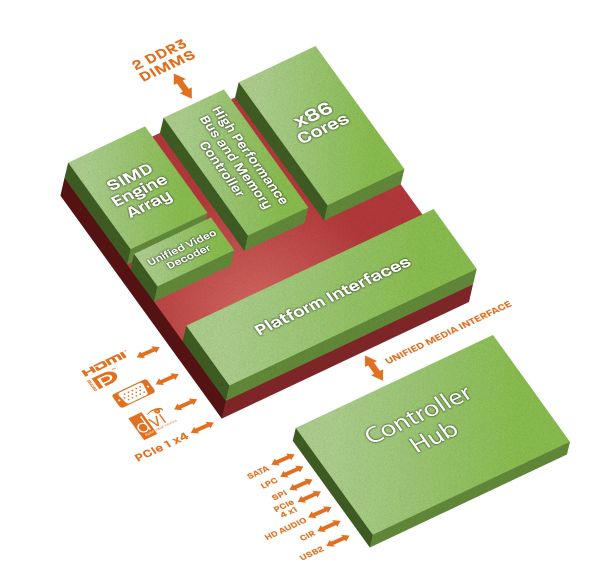AMD G-Series Brings APUs to the x86 Embedded Market
by Ganesh T S on January 19, 2011 12:29 AM ESTThe embedded market is huge and growing, and needs innovative, complete system platforms. These systems are compute intensive and have high performance graphics requirements, which make the embedded market a key part of AMD's strategy to drive revenue growth. There is an ongoing push for decreased power, smaller size and higher capability systems at lower price points. The strong visual element and growing need for quality graphics in many embedded markets such as set top boxes make it the ideal time for the AMD APU to get introduced into this space.

AMD's solutions (integrated CPU + GPU) are ideal for thin clients, medical imaging, point of sale and kiosk systems, gaming machines, digital signage and single board computing systems. These APUs integrate a multi-core CPU and a GPU sub-system on the same die to give a general-purpose, programmable scalar and vector processor core with heterogeneous capabilities.
The AMD Embedded G-Series Platform consists of an APU and a Fusion Controller Hub. The features are as below:
APU
- 2 x86 CPU Cores (40nm “Bobcat” core – 1 MB L2, 64-bit FPU)
- C6 and power gating
- Array of SIMD Engines [ DX11 graphics performance, Industry leading 3D and graphics processing ]
- 3rd Generation Unified Video Decoder [ H.264, VC1, DivX/Xvid ]
- DDR3 800-1066, 2 DIMMs, 64 bit channel
- BGA package
AMD Fusion Controller Hub for display and I/O
- Two dedicated digital display interfaces [ Configurable externally as HDMI, DVI, and/or Display Port, and as single link LVDS for internal panels ]
- Integrated VGA
- 5x8 PCIe®
- “Hudson” Fusion Controller Hub
With the introduction of the G-Series, AMD is showing a strong commitment to the x86 embedded market. AMD claims that it is the world's first and only APU for embedded systems. AMD Fusion can bring a new generation of differentiated, small form factor embedded systems that consume less power, yet deliver improved performance and features. The GPU component can deliver an outstanding visual experience compared to other x86 based embedded systems.
We are reproducing the different SKUs available for the APU as well as the platform controller hub (PCH) from AMD's official site below (click to enlarge):
Given ATI's strong GPU background, there is no doubt that the graphics in the G-Series will turn out to be much better than the embedded solution from Intel and VIA. However, we do have some concerns about the capability of the UVD engine in the platform. While the marketing slides indicated that Blu-Ray titles can be smoothly played back, it also had another entry indicating that 1080p video playback support availability was only in the 18W processors and higher. We were also not provided with the difference between the embedded G-Series and the desktop Brazos platform that Anand had covered earlier. It looks likely that the GPU capabilities (SIMD engine) are not the same, with the embedded solution having half the number of stream processors. However, we are awaiting confirmation on this. Expect an update in this section as soon as we hear back from AMD.













76 Comments
View All Comments
Shadowmaster625 - Wednesday, January 19, 2011 - link
Most embedded devices do not have a display controller. At most, they will have a simple serial port that can be used to send text to a terminal. They do not require a great deal of processing power. Usually they need just enough cpu power to keep the I/O buffers filled. Thus they use ARM.For some, the added convenience of being able to develop and execute code on the same platform vastly outweighs the cost of a display controller. I for one know it is a hell of a lot easier to write and debug code for an xp-embedded system than it is to code for some little piece of garbage that I might or might not have ever worked with and might or might not ever work with again! You can get a project done in half the time by using as much of your standard development platform as possible. And yes if necessary, later port it over to a more power efficent platform if the volume warrants it.
milkylainen - Wednesday, January 19, 2011 - link
Yes, you are right that most embedded devices don't have a display controller such as a complex framebuffer with raster-ops etc. Most embedded devices reside in washers, elevators and buckedloads of stuff most of us take for granted. That's the core of embedded. But the analogy of using ARM devices are still just plain wrong. Look for example at the Cortex A9. SMP dual core, up to 2GHz class cpu's with up to 4M L2. Full display controller, security engines etc etc etc.They will still develop, in a normal configuration, their max performance within _MILLIWATT's_ of power envelope, typical PEAK. (something like 250-500mW perhaps). That's what will be residing in complex portable devices like whatever-pads and telephones. x86 in anything that has a week of uptime? Not as far as the current showings from AMD and Intel goes.
Good luck integrating something with a fan in a ultrathin pad of some sort.
x86 is still confined to rather large devices with large battery packs and abysmal uptime. That's why I don't like the frivolous use of "Embedded".
milkylainen - Wednesday, January 19, 2011 - link
Just an addon. The Cortex A9 is a CPU complex. They are typically integrated as hard macros in a modern process with display controllers etc. It's not a SoC.Muhammed - Wednesday, January 19, 2011 - link
I am sorry , but this is not like the usual quality articles I always read on Anandtech , this just a regurgitation of marketing statements and flashy banners , The article added zero information to my knowledge which seemed very odd to me considering my solid experience with this site .Worse , what's being presented in the article is not at all revolutionary , or even exciting , may be for some corporate folks , but not for the general population , the new platform delivers solid price/performance ratio for sure , however on the performance front and/or the power consumption front , it's nothing special .. Yet the way it is presented in the article may make it sound like the new "Core i7" .
Some of the paragraphs really shocked me , it made me wonder whether I am reading an article on a different "news" site , I know Anand and it's staff can do better than this , and I hope no to see this kind of press ever again on this well respected place .
ganeshts - Wednesday, January 19, 2011 - link
This piece has been specifically categorized as a 'news piece', in which case we don't have any hardware to test out / characterized / determine performance or suitability for any particular application. As such, we can just do analysis of the press release provided to us with the information available at our disposal.Please do keep a lookout for our reviews where you will find extensive analysis and performance testing of the gadgets / chips under the scanner.
krumme - Wednesday, January 19, 2011 - link
Damn it was fast. It must be the synthesized methology working big time.For me it just looks like the same stuff but with added integration - under the name embedded :), - but guess its what the OEMs wantet. Next is probably the southbridge :)
zodiacfml - Wednesday, January 19, 2011 - link
........ go AMD!!! :pblowfish - Wednesday, January 19, 2011 - link
You write that the AMD APU may be competitive with the ARM solutions from a power perspective when it's built on a smaller node (I think you suggested a couple of generations from the current 40Nm) Is that comparing with ARM still built on the current node though? Wouldn't the inherent power efficiency of ARM processors mean that when built on similar node size, they would always be more power efficient?Shadowmaster625 - Wednesday, January 19, 2011 - link
The embedded market is huge. And it is not as concerned with power use as you might think. Atom with XP-embedded has made huge inroads. Brazos with 7-embedded could do even more. They have to get this out there in as many segments as possible so that people can start developing unique APU code. There are some very niche functions in the embedded world that could be done much faster with SIMD arrays. AMD needs to get that 100th monkey effect as quickly as possible.SlyNine - Wednesday, January 19, 2011 - link
"In the meanwhile, solutions like what we are seeing from AMD today integrate premium graphics capabilities within power envelops similar to what --x86-- used to consume in the previous generation."Should that read
"In the meanwhile, solutions like what we are seeing from AMD today integrate premium graphics capabilities within power envelops similar to what --RISC-- used to consume in the previous generation."